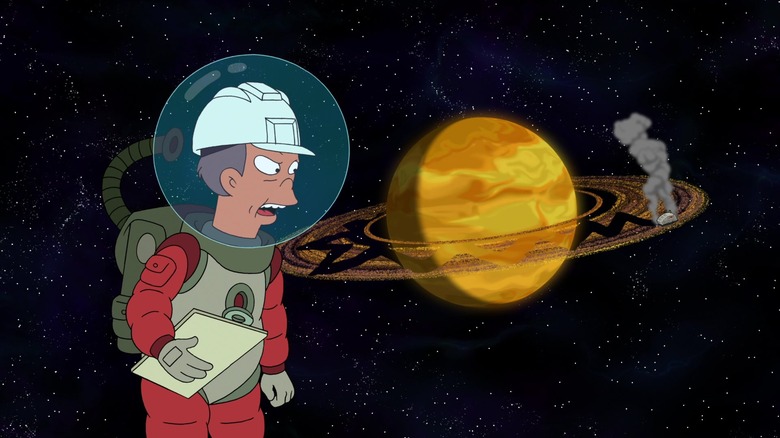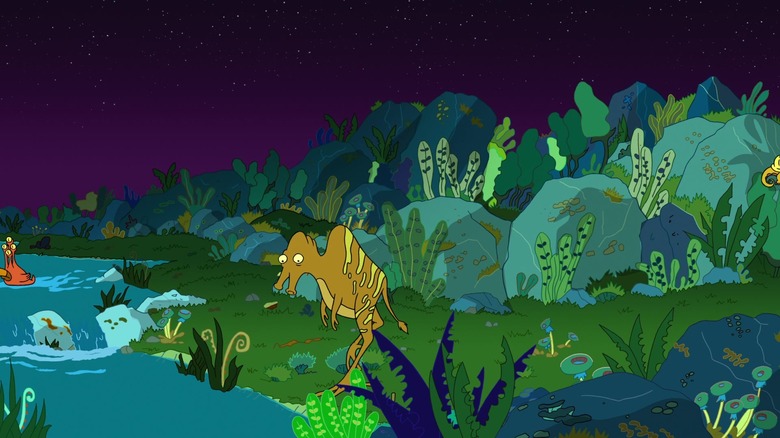The Main Sci-Fi Inspiration Behind Futurama's Into The Wild Green Yonder
The fourth "Futurama" movie, "Into the Wild Green Yonder," was released on DVD on February 24, 2009, and it was intended to be the final word on the series ... again. The initial run of "Futurama" ended in 2002 after encountering poor ratings. DVD sales of the show remained robust, however, and Fox agreed to make four straight-to-video "Futurama" movies as a way of resurrecting the series for what was essentially one final season. The four movies did better than expected, and Comedy Central picked up "Futurama" for a third run, starting in 2010. "Futurama" is the brain that wouldn't die.
But for a while, it looked like "Into the Wild Green Yonder" was going to be the last time audiences would ever see "Futurama," and the makers wanted the story to be appropriately epic. The story of "Green Yonder" involves a sudden cosmic surge of Chi, or life-giving energy, that spontaneously pulsates into the galaxy. The Chi terraforms a small asteroid in a violet dwarf system, causing a new panoply of life forms to begin rapidly evolving there. Before too long, the asteroid is the lushest biome in the galaxy.
The asteroid is threatened by the unthinking construction of a galaxy-wide golf course, committed by Leo Wong (Billy West), the father of Amy (Lauren Tom). The asteroid is also under threat from the deathly energies emitted by an off-screen race of primordial demons called the Dark Ones. The ultimate fate of the asteroid is similar to a plot point in the movie "Eternals."
"Futurama" co-creator David X. Cohen talked to MovieWeb back in 2009, and discussed how he wanted "Green Yonder" to be an epic tale of massive sci-fi implications. As such, perhaps naturally, he aimed to imitate Stanley Kubrick's 1968 classic "2001: A Space Odyssey."
The violet dwarf system
Of course, "2001: A Space Odyssey" is one of the best films of all time, and maybe one of the most famous, so any and all sci-fi stories likely owe the Kubrick/Arthur C. Clarke story a debt. Cohen was open about the influence, saying:
"A little bit of inspiration, as you'll see at the end, from '2001.' Not that we ripped off too much, but just a little bit of the visuals at the end. That, I would say, would be one of the greatest sci-fi movies of all time. Aside from that, that's the main one."
Naturally, this isn't the first time "Futurama" referenced "2001: A Space Odyssey." To cite only one other example: in the episode "A Bicyclops Built for Two" (March 19, 2000), the main characters logged into the internet — a vast VR experience in the future — and were greeted by Richard Strauss' "Also Sprach Zarathustra." Fry (West) whispered "My God. It's full of ads!," a reference to Dave (Keir Dullea) saying "My God, it's full of stars" in "2001."
The end of "Into the Wild Green Yonder" sees the lush asteroid reach a level of biodiversity that causes the entire planetoid to transform. It becomes a massive sperm, flies toward the violet dwarf star, fertilizing it. The fertilized star quickly gestates and hatches into an Encyclopod. The Encycolpod is a massive cosmic stingray that has the DNA of billions of endangered species encoded in villi on its stomach. It's a living DNA vault.
The cosmic "hatching" was essentially the Star Child from "2001." Clearly, Cohen wanted to tell a sci-fi story on a massive scale, reaching into the fabric of life and its place in the cosmos. "Green Yonder" may not be as profound as "2001," but it is undeniably funnier.

